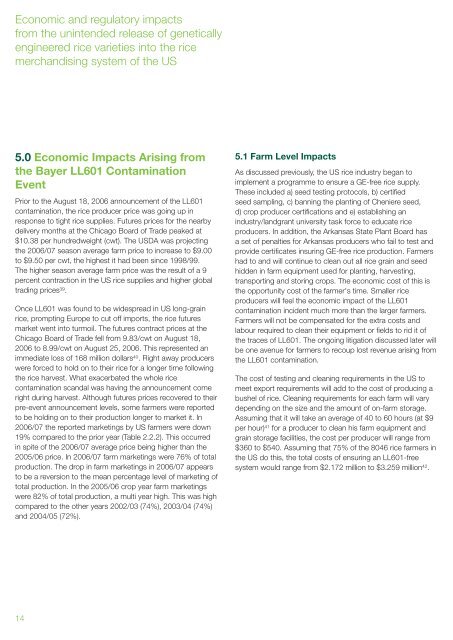Risky Business - Greenpeace
Risky Business - Greenpeace
Risky Business - Greenpeace
Create successful ePaper yourself
Turn your PDF publications into a flip-book with our unique Google optimized e-Paper software.
Economic and regulatory impacts<br />
from the unintended release of genetically<br />
engineered rice varieties into the rice<br />
merchandising system of the US<br />
5.0 Economic Impacts Arising from<br />
the Bayer LL601 Contamination<br />
Event<br />
Prior to the August 18, 2006 announcement of the LL601<br />
contamination, the rice producer price was going up in<br />
response to tight rice supplies. Futures prices for the nearby<br />
delivery months at the Chicago Board of Trade peaked at<br />
$10.38 per hundredweight (cwt). The USDA was projecting<br />
the 2006/07 season average farm price to increase to $9.00<br />
to $9.50 per cwt, the highest it had been since 1998/99.<br />
The higher season average farm price was the result of a 9<br />
percent contraction in the US rice supplies and higher global<br />
trading prices 39 .<br />
Once LL601 was found to be widespread in US long-grain<br />
rice, prompting Europe to cut off imports, the rice futures<br />
market went into turmoil. The futures contract prices at the<br />
Chicago Board of Trade fell from 9.83/cwt on August 18,<br />
2006 to 8.99/cwt on August 25, 2006. This represented an<br />
immediate loss of 168 million dollars 40 . Right away producers<br />
were forced to hold on to their rice for a longer time following<br />
the rice harvest. What exacerbated the whole rice<br />
contamination scandal was having the announcement come<br />
right during harvest. Although futures prices recovered to their<br />
pre-event announcement levels, some farmers were reported<br />
to be holding on to their production longer to market it. In<br />
2006/07 the reported marketings by US farmers were down<br />
19% compared to the prior year (Table 2.2.2). This occurred<br />
in spite of the 2006/07 average price being higher than the<br />
2005/06 price. In 2006/07 farm marketings were 76% of total<br />
production. The drop in farm marketings in 2006/07 appears<br />
to be a reversion to the mean percentage level of marketing of<br />
total production. In the 2005/06 crop year farm marketings<br />
were 82% of total production, a multi year high. This was high<br />
compared to the other years 2002/03 (74%), 2003/04 (74%)<br />
and 2004/05 (72%).<br />
5.1 Farm Level Impacts<br />
As discussed previously, the US rice industry began to<br />
implement a programme to ensure a GE-free rice supply.<br />
These included a) seed testing protocols, b) certified<br />
seed sampling, c) banning the planting of Cheniere seed,<br />
d) crop producer certifications and e) establishing an<br />
industry/landgrant university task force to educate rice<br />
producers. In addition, the Arkansas State Plant Board has<br />
a set of penalties for Arkansas producers who fail to test and<br />
provide certificates insuring GE-free rice production. Farmers<br />
had to and will continue to clean out all rice grain and seed<br />
hidden in farm equipment used for planting, harvesting,<br />
transporting and storing crops. The economic cost of this is<br />
the opportunity cost of the farmer's time. Smaller rice<br />
producers will feel the economic impact of the LL601<br />
contamination incident much more than the larger farmers.<br />
Farmers will not be compensated for the extra costs and<br />
labour required to clean their equipment or fields to rid it of<br />
the traces of LL601. The ongoing litigation discussed later will<br />
be one avenue for farmers to recoup lost revenue arising from<br />
the LL601 contamination.<br />
The cost of testing and cleaning requirements in the US to<br />
meet export requirements will add to the cost of producing a<br />
bushel of rice. Cleaning requirements for each farm will vary<br />
depending on the size and the amount of on-farm storage.<br />
Assuming that it will take an average of 40 to 60 hours (at $9<br />
per hour) 41 for a producer to clean his farm equipment and<br />
grain storage facilities, the cost per producer will range from<br />
$360 to $540. Assuming that 75% of the 8046 rice farmers in<br />
the US do this, the total costs of ensuring an LL601-free<br />
system would range from $2.172 million to $3.259 million 42 .<br />
14

















